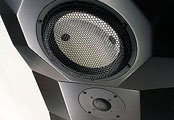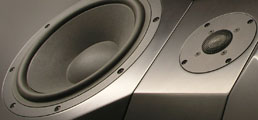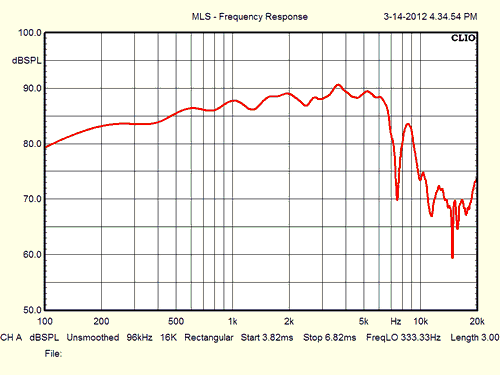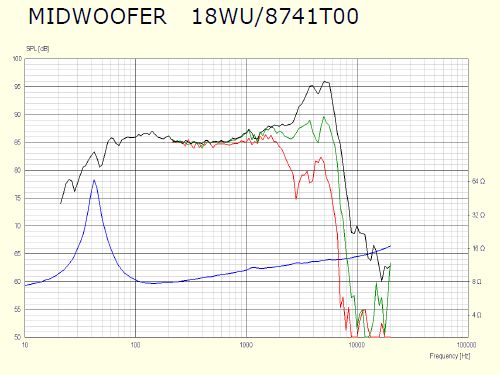|
The
Jenzen speakers
|
|
Why do the Jenzen speakers have a stepped front panel? Why do all feature 2nd order Linkwitz-Riley filters and why do they have the particular front panel designs? Below you will find some of the rationales behind this speaker range. The Jenzen series of speakers
are meant to offer high-end sound for low-end price, even for the
constructions with expensive drivers. As discussed in Speakers' Corner;
what diy people can do speaker manufacturers cannot, is this: Spoil our
drivers with the best of cabinet work. MDF is cheap and it's no problem
making 30-50 mm panels and adding solid bracing to produce
low-resonance enclosure that is often a significant part of high-priced
speakers. Cabinet resonances add more to the sound than we may think. THE CROSSOVER The question is how wide the overlap has to be, and from my experience some two octaves below and above point of crossover. As soon as we are some 12+ dB below summed response we can have the drivers' roll-off as steep as it may be. To realise a 1st order filter I would pick at least four drivers. And again, I have to point to Vandersteen, who probably do the right thing in making an extremely broad-banded 4" upper-mid driver providing a huge overlap to lower-mid (8" driver) and tweeter. Finding a 3-4" driver that can do this is actually not that difficult, e.g. the ScanSpeak Illuminator 12MU is an example. Now, having four drivers all providing 1st order roll-off two octaves
above and below points of crossover - and all being connected with
positive polarity - takes serious equalisation and the
crossover becomes complex due to e.g. all-pass filters - and a lot of energy is getting lost. The result is an appallingly low efficiency. Vandersteen's top
model doesn't make more than 83.5 dB/2.8V and needs a lot of power
to come alive, thus a 400 subwoofer in-built subwoofer. It may sound
wonderful - I never heard it - but I guess this is as far away from a
100dB 15" driver in an e.g. 220 liter Onken cabinet - or open
baffle - as can be. Another thing key issue with 1st order crossover is the endless search for
drivers that will be make a good blend of sound as the drivers over a
wide frequency range will do the same thing - but their way. 2 kHz from a
1" dome and a 4" mid-driver just does not sound the
same. This leaves the 2nd order filter (LR2) as the best compromise when it comes to sonics and power handling. Only thing is that we need to time-align the mid and tweeter to make a text-book LR2 filter work properly. Sometimes we can get away with a tilted front panel like the Illimina 66 and simple crossover tricks to make a flat frequency response and a decent phase integration - or use an all-pass filter to delay tweeter response. The latter makes a rather complex crossover although it can work very well with proper capacitors. Proper phase integration is often grossly neglected in commercial designs and the question is: How good does phase integration really has to be - to be good enough? Because it can never be perfect as phase integration depends on where we position ourselves with regard to the speakers. Common practice in testing good phase integration is to set up the microphone between the two drivers and reverse polarity of one of the drivers. This should produce a significant dip in frequency response from a well constructed crossover. As we could see from the Chario Sonnet speaker, phase integration was anything but good, but yet it has a pleasant sound. Chario here claims that phase behavior of the two drivers does not have to be coincident, rather parallel over a wide frequency range and that placing the point of crossover in the 1-2 kHz range, where our ability to locate sound is poor, does the trick. Right or wrong, this speaker performs very well indeed. To my experience two drivers displaying poor phase integration - but having parallel phase slopes - can sound very good indeed, but the the more out of phase the two drivers are, the more we create some "phasiness" in the overall sound, which may be perceived as enhanced three-dimensionality, sense of depth. Cheap trick? Placing a point of crossover at 200 Hz where we have a wavelength of 34400/200 = 172 cm, does not
necessitate time-aligning drivers. It will have no significant impact
on sound and as long amplitude is fairly flat, we're well off. To find out the acoustic delay of the
drivers we can do this: We place the microphone at 1 meter distance
between mid and tweeter and record amplitude and minimum phase for both
drivers and finally the summed response (impedance data not needed
here). It is important the microphone is not moved during these
measurements. Next we take the data files to the LspCAD6 software and simulate
a 3-way crossover with tweeter, mid and summed response as the three
drivers. The measured summed response is disabled in the SPL/Xfer
function, thus does not add to the total summed response. This will produce 4 graphs, tweeter, mid, mid+tweeter and
summed response of mid+tweeter. Next we change dZ for middriver until
summed response coincides with mid+tweeter response at suggested point
of crossover, because what we also find is that the dZ is not
consistent with frequency. Usually a middriver will change its phase
behavior because not all parts of the cone may produce the same
frequencies.
At higher frequencies it may only be the center of the speaker, e.g.
dust-cap, that does what it should do. We will find dZ for most 6" drivers to be around 25-35 mm relative to a standard 1" dome. With the middriver on top and suggested listening position at tweeter height the middriver will be a little further away from the listening point and we may get away with the middriver being some 18-25 mm in front of the tweeter as can be seen from the various Jenzen mid-cabs. The ScanSpeak Illuminator is a particular "deep" driver, thus some 27-29 mm is recommended here. Plus/minus 1-2 mm doesn't change a thing so don't take this too literally. There are a lot of things to dynamic drivers that aren't perfect so this not is the place to be nitpicking although high-end manufacturers will tell you another story. THE BAFFLE
SUMMARY:
Jenzen SEAS ER, SEAS CA25RFX, CA18RNY and T25C003/T25CF001 Jenzen NEXT, SEAS W26FX002, W18NX001 and T25C003/T29CF002 Jenzen Accu, Audio Technology 10C77-25-10-KAP, Accuton C173-6-191E and Accuton C30-06-024 Jenzen Illuminator, ScanSpeak W26/8861T00, 18WU/8741-T00 and D3004/660000 Also check out how a range of 6" drivers perform on the Jenzen front panel. |




